Lowell
Settlers arrived in Chelmsford, about 5 km (3 miles) south of the Merrimack River in 1653. By the early 18th century the 10 metre (32 foot) high Pawtucket Falls on river had become important as a source of power; a sawmill and gristmill were soon followed by a fulling mill. Textile merchant Francis Cabot Lowell visited Britain in 1810 to to investigate power looms used to produce textiles. Because of the Napoleonic Wars, Britain had placed an embargo on the USA which stopped Lowell from importing machines, but he got round this by memorising their design. Following his return the information he had gleaned helped to build power looms for a cotton mill in Waltham, Massachusetts. Lowell died in 1817 but his successor Patrick Jackson decided to open a second cotton mill taking power from the Pawtucket Falls. The mill opened in 1823 and was so successful that further mills followed. In 1826 the booming population of the Pawtucket Falls area resulted in it being spun off from Chelmsford as the town of Lowell, named after Francis Cabot Lowell. By the mid 1800s Lowell was the largest industrial centre in the USA and apart from the Civil War period it boomed right through to the early 20th century. By the 1920s Lowell had gone into decline due to outdated machinery and widespread strikes. By 1960 the mills were derelict and Lowell was in serious decay. Lowell National Historical Park was created in 1978 to preserve the structures remaining from the heyday of the city. New jobs in technology helped to reverse the decline of the city from the 1980s.
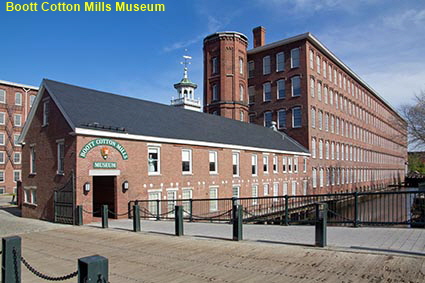
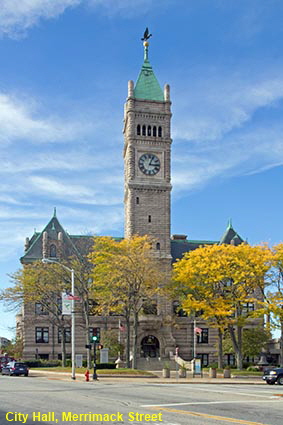
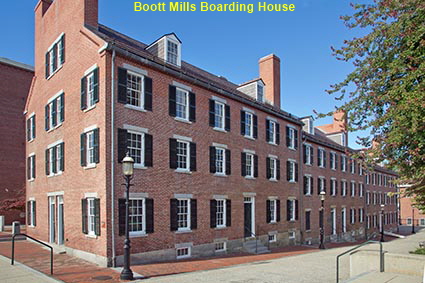
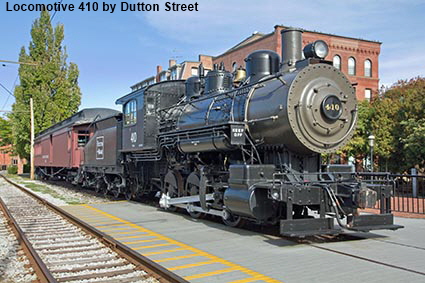
Click on Minimap to navigate
Home > US States > New England > Massachusetts >
Locomotive 410 by Dutton Street
Steam Locomotive 410 was built for the Boston & Maine Railroad by the Manchester Locomotive Works in Manchester, New Hampshire. She entered service in June 1911 and was used for shunting wagons between the railroad and industrial yards. She was based at several B&M locations including Lowell. By 1950 she had been rendered obsolete by diesel locomotives and was sold to a quarry in Westford, Massachusetts. She worked there for nearly 2 years but was abandoned because she needed costly maintenance work. The abandoned locomotive was later acquired by the Commonwealth of Massachusetts who planned to preserve her at the Museum of Transportation in Boston. She was moved to the B&M Shops at North Billerica, Massachusetts in preparation for preservation but the plans never came to fruition. In 1992 the B&M Railroad Historical Society embarked on the cosmetic restoration of Locomotive 410, and in 1993 when the work had been completed she was put on display in Dutton Street, Lowell.
City Hall, Merrimack Street
The original Lowell City Hall built in 1830 was a small building which by the 1880s had become too small for the rapidly expanding city. Having grown to be the largest industrial centre in the USA, Lowell needed a new City Hall that was both large and impressive. In 1888 a commission was established to oversee the design and construction of a new City Hall. It was to be located on a site purchased from the Merrimack Manufacturing Company in 1879. A design competition attracted 23 entries and from these three finalists were selected. Lowell architectural firm of Merrill Cutler received the third prize but after making changes to the design of their proposed tower they were awarded the contract. The cornerstone was laid in July 1890 and the building was dedicated on October 14, 1893. The exterior is dominated by its 55 metre (180 foot) high tower and inside it has 69 rooms. The rich interior includes stained glass, cast iron stair railings, decorated capitals, and ornate golden oak woodwork. Lowell City Hall is one of the architectural gems of New England and it is now is the centrepiece of the City Hall Historic District.
Boott Mills Boarding House
Rapid growth of the workforce meant that in the 19th century finding somewhere to live was a major problem. To attract new workers to move to Lowell, the mills built boarding houses for single employees while tenements were built for those who were married. Many of the workers were ‘Mill Girls’, unmarried females mainly from the rural villages and farms of New England. They were housed in separate boarding houses from the men where they could be closely supervised. Any mill girl who was considered to have indulged in rowdiness, intemperance, illicit relations with men, or regular failure to attend worship on the Sabbath risked dismissal from the mill and losing her place in the boarding house. The boarding houses continued to operate into the 20th century, but as the mills declined and closed most of them were left to decay and eventually demolished. Fortunately, the Boott Mills boarding houses survived and now form part of the National Historical Park giving the opportunity to see how the mills girls lived.
Boott Cotton Mills Museum
The Boott Mills were founded by Kirk Boott and opened in 1835, drawing their power from the nearby Pawtucket Falls. The long mill buildings were once filled with thousands of power looms. The mill provided employment for many workers who produced out millions of yards of textiles each year. Amongst the employees were many women and some children. Boott Mills closed in the 1950s but unlike many of the other mills in Lowell, the buildings were not demolished. Much of the space in the old buildings was converted to condominiums, apartments and offices. In the late 1970s, Lowell National Historical Park was set up to preserve and explain the history of Lowell. A museum was built in the former Boott Mills including a Weave Room filled with working (and noisy) power looms.
DLU171219


To move forwards or backwards through the Massachusetts trail click the arrows above, or select your next destination on the Minimap.
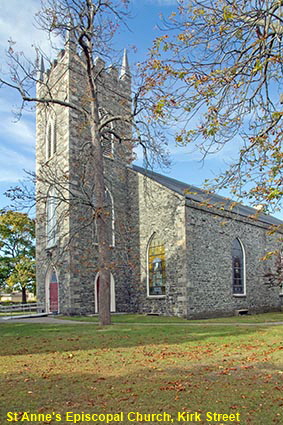
St Anne's Episcopal Church, Kirk Street
The owners of the mills newly built alongside Pawtucket Falls were keen to ensure that their workers were able to participate in Sunday worship. In December of 1822, Kirk Boott, the founder of Boott Mills, and the directors of the Merrimack Manufacturing Corporation appointed a committee to oversee the construction of a church for their workers. The plans of the church were drawn up by Mr Boott himself. Anyone from the UK will find the church that he designed looks rather familiar, which is because Mr Boott based his design on an English church, St. Michael’s in Derby. When it was consecrated on March 16, 1825, St. Anne’s was the first church in the part of Chelmsford that became Lowell. St. Anne’s Episcopal Church is still actively used for worship.
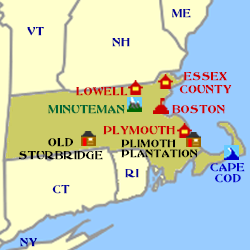

© Mike Elsden 1981 - 2025
The contents of this page may not be reproduced in full or in part without permission